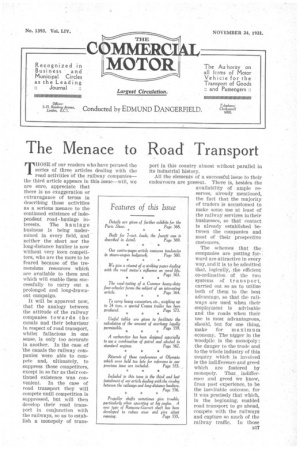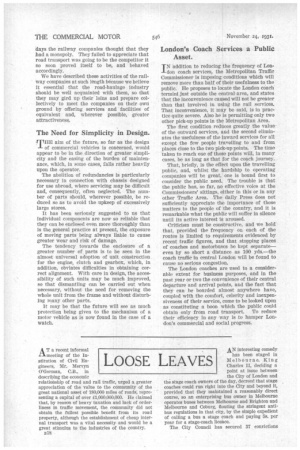The Menace to Road Transport
Page 35

Page 36

If you've noticed an error in this article please click here to report it so we can fix it.
THOSE of our readers who have perused the series of three articles dealing with the road activities Of the railway companies— the third article appears in this dssue—will, we are sure, appreciate that there is no exaggeration or extravagance of terms in describing those activities as a serious menace to the continued existence of independent road haulage interests. The haulage business is being undermined in every field, and neither the short nor the long-distance haulier is now without very keen competitors, who are the more to be feared because of the tremendous resources which are available to them and which will enable them successfully to carry out a prolonged and long-drawnout campaign.
It will be apparent pow, that the analogy between the attitude of the railway companies towards the canals and their behaviour in respect of road transport, whilst fallacious in one sense, is only too accurate in another. In the case of "the canals the railway companies were able to compete and, ultimately, to suppress those competitors, except in so far as their continued existence was convenient. In the ease of road transport they will compete until competition is suppressed, but will then develop their road transport in conjunction with the railways, so as to establish a monopoly of trans port in this country almost without parallel in its industrial history.
All the elements of a successful issue to their endeavours are present. There is, besides the availability of ample reserves, already mentioned, the fact that the majority of traders is accustomed to make some use at least of the railway services intheir businesses, so that• contact is already established between the companies and most of their prospective customers.
The schemes that the companies are putting for, ward are attractive in every way, and it Is to be admitted that, .logically, , the efficient co-ordination Of the two systems of transport, carried out so as to utilize both of them to the best advantage, so that the railways are used when, their employment is advisable and the roads when their Use is most advantageous, should, but for one thing, make for maximum economy. The nigger in the woodpile is the monopoly: the danger to the trade and to the whole industry of this comary. which is involved is the indifference and greed which are fostered by monopoly. That indifference and greed we know, from past experience, to be the inevitable outcome, for it was precisely that which, in the beginning, enabled road transport to go ahead, compete with the railways and capture so much of the railway traffic. In those days the railway companies thought that they had a monopoly. They failed to appreciate that road transport was going to be the competitor it so soon proved itself to be, and behaved accordingly.
We have described these activities of the railway companies at such length because we believe it essential that the road-haulage industry should be well acquainted with them, so that they may gird up their loins and prepare collectively to meet the companies on their own ground by offering services and facilities of equivalent and, wherever possible, greater attractiveness.




































































































